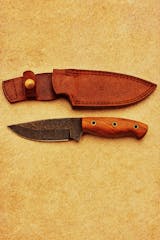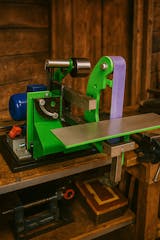Havoc Abrasives
2x72 Inch Sanding Belts for Knifemaking
2x72 Inch Sanding Belts for Knifemaking
Sanding belt kits ship free
Sanding belt kits ship free
Sanding belt kits are designed to ship free regardless of the price.
Not sure what your belt progression should look like?
Not sure what your belt progression should look like?
There's some great rules of thumb for many knifemakers.
- Generally, you're probably going to start with a 36 grit sanding belt. Almost always, a ceramic belt holds up to steel and rough grinding or stock removal to justify the higher price. Then you're going to double your grit to the closest grit.
- We typically see progressions that look like: 36 grit ceramic ➡️ 60 grit ceramic ➡️ 120 grit ceramic ➡️220 grit J-Flex aluminum oxide ➡️ very fine non-woven surface conditioning belt
- Consider using older and more worn 36 grit ceramic belts to start new stock removal blades. Their life is very long-lasting and newer edge belts can be used for other difficult jobs
- Consider starting at a finer grit, 60 or 80 grit, for thin stock, roughly 1/8" or finer.
Tips for better grinding
Tips for better grinding
- Heat is your enemey. However at rougher grits with high pressure, (say 100 grit and below), you remove enough stock that the heat goes with it. This means the finer grits can have more trouble with heat than the coarser grits.
- Aluminum Oxide x-weight (sometimes referred to as AOX), is your general purpose sanding belt. Knifemakers often like the J-Flex aluminum oxide for it's extreme flexibility. If it's run as a slack belt, one can lean in with a handle for example and contour smooth a wooden or resin handles.
- Sanding belts can load with soft material between the abrasive grains. Utilizing a rubber belt eraser can fix this issue. The rubber acts like a cleaning stick that removes the build up of soft material that prevents abrasive grinding as the belt becomes smooth with soft build-up.
Couldn't load pickup availability
Havoc Abrasives Sanding Progression Recommendation
- All of our 2" x 72" sanding belts curated for the needs of the knifemaker. We generally recommend with steel to start at 36 grit, and double each grit (approximately). This would provide a progression of 36 grit ceramic, 60 grit ceramic, and then 120 grit ceramic.
- Note: some prefer 80 grit ceramic to have an less drastic jump to 120 grit though many find they don't need the additional step.
- If working with thinner steel 1/8" or thinner steel, the 36 grit may remove material very quickly making it harder to use as you approach the final shape of the blade during stock removal. Consider starting with 60 grit ceramics if this is the case.
Share























I always try ceramics, even just a few, to compare pricing and life. These had great life and the price is right. Fan of the norton blaze belts, but don't think they quite hold up when it comes to price for the price you pay. Put some pics of small knives i worked on to test out the 36 grit. Kind of grainy, but need to add more lights in the shop.
I'm really happy with these purple belts. THey seem to really last a lot on stock removal. Honestly, the ceramics are the most expensive and I try to get the best life out of them as those are the workhorses. Had a minor question on the grits, and got an answer right away through the message app.
The belts work great, really no issue. But the post office seemed to have dropped the box a hundred times on the way to my door. Box was retaped together it looks like. That said the belts weren't damaged.
I've only tried a few other ceramics, mostly stuff I've found ordering from a local small supplie shop. This seems to work much better. I got the 36 grit, 60 and 120 grit belts to use before heat treatment. Happy.





